إحصائيات الموضوع | |
موقع تعليم المربعات السحريه او الاوفاق السحريه Ultramagic Squares of Order 7 Cells Coordinates (x,y) 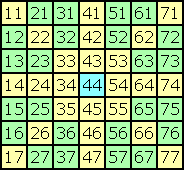 The 49 cells of an order-7 magic square are adressed by two coordinates x and y. Cell (x,y) or shortly xy is situated in row x and column y. The rows and columns were counted from 1 to 7. The upper lefthand cell has the adress (1,1). (Only for special purposes like transposition-formula we also use coordinates x, y from 0 to 6.) The square on the left shows the adress of each cell. The 49 cells of an order-7 magic square are adressed by two coordinates x and y. Cell (x,y) or shortly xy is situated in row x and column y. The rows and columns were counted from 1 to 7. The upper lefthand cell has the adress (1,1). (Only for special purposes like transposition-formula we also use coordinates x, y from 0 to 6.) The square on the left shows the adress of each cell.The blue centre-cell has the adress (4,4) or 44. I call the 24 yellow cells axis-cells and the 24 green cells filling-cells. It is of great importance to divide the square without centre-cell in these two segments. Natural numbers n(x,y) 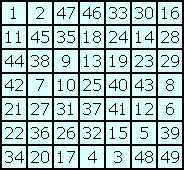 It is usual to fill the cells of a 7x7-squares with consecutive natural numbers from 1 to 49. I use this way for printing squares but not for calculating squares. The square on the left is self-complementary and pan-magic. n(x,y) is the number in cell (x,y). For example n(6,5) = 12 in this square. n(4,4) = 25 in each self-complementary 7x7-square. Two numbers located symmetrically about the centre-cell sum up to 50. This could be expressed by the equation n(x,y) + n(8-x,8-y) = 50. It is usual to fill the cells of a 7x7-squares with consecutive natural numbers from 1 to 49. I use this way for printing squares but not for calculating squares. The square on the left is self-complementary and pan-magic. n(x,y) is the number in cell (x,y). For example n(6,5) = 12 in this square. n(4,4) = 25 in each self-complementary 7x7-square. Two numbers located symmetrically about the centre-cell sum up to 50. This could be expressed by the equation n(x,y) + n(8-x,8-y) = 50. Integers i(x,y) 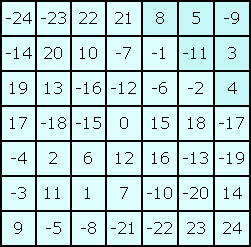 The cells of the square on the left are filled with whole consecutive numbers from -24 to 24. This square is equivalent to the above square. The cells of the square on the left are filled with whole consecutive numbers from -24 to 24. This square is equivalent to the above square.i(x,y) = n(x,y) - 25 is the integer in cell (x,y). This numeration has many benefits for the calculation of odd-order magic squares. i(4,4) = 0 in each self-complementary 7x7-square. Integers with the same absolute value a(x,y) = |i(x,y)| are located symmetrically about the centre-cell: i(x,y) = -i(8-x,8-y) or a(x,y) = a(8-x,8-y). The integers in each column, row or diagonal add up to zero. You get a homogeneous system of equations. There are derived equations that contain only 6 variables. The sums of several 6-cell-triangles are zero in each self-complementary pan-magic order-7 square. See for instance the upper righthand triangle of the square on the left: 8 + 5 - 9 - 11 + 3 + 4 = 0 غير مبريء الذمه نقل الموضوع أو مضمونه بدون ذكر المصدر: منتديات الشامل لعلوم الفلك والتنجيم - من قسم: حسابات وبرامج
|
المشاركة : (2) | |
25 equations from the self-complementary property A magic square s is self-complementary if there exists a general square-transformation T (i.e. rotation or reflection) with C·T(s) = s. Where C is the complementary-transformation, that changes the numbers of an order-7 square in the following way: C:n(x,y)-->50-n(x,y) with natural numbers, or C:i(x,y)-->-i(x,y) with integers. If the order of the square is odd, T has to be the 180°-rotation: T:i(x,y)-->i(8-x,8-y) Proof: All axis reflections have 7 fixed cells that are in a row, a column or a main diagonal. But as C has only one fixed point, namely cell (4,4), C·T could not be the identical transformation. We get C·T:i(x,y)-->-i(8-x,8-y) and as we consider self-complementary squares C·T:i(x,y)-->i(x,y). ==> i(x,y)=-i(8-x,8-y) Let us use the shortform ixy for the integer i(x,y). We get 25 equations: 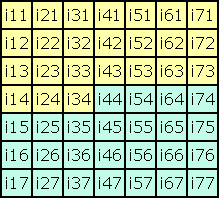 i15=-i73, i25=-i63, i35=-i53, i16=-i72, i26=-i62, i36=-i52, i17=-i71, i27=-i61, i37=-i51, i44=-i44, i54=-i34, i67=-i21, i74=-i14 i45=-i43, i55=-i33, i65=-i23, i75=-i13 i46=-i42, i56=-i32, i66=-i22, i76=-i12 i47=-i41, i57=-i31, i67=-i21, i77=-i11 The equation i44=-i44 is only fulfilled by i44=0. If you know the 21 numbers of the first three rows and the first 3 numbers of the fourth row, you know the whole square. Thus we have to consider only 24 variables, the yellow part of the square. Three row-equations If the numbers in the first three rows sum up to 0, then also the numbers in the rows 5, 6 and 7 sum up to 0, because their numbers are negative to that in row 3, 2 and 1. The sum in row 4 is automatically correct: i14+i24+i34+i44+i54+i64+i74 = i14+i24+i34+i44-i34-i24-i14 = i44 = 0 The tables show a geometrical interpretation of the equations. (A) i11+i21+i31+i41+i51+i61+i71 = 0 (B) i12+i22+i32+i42+i52+i62+i72 = 0 (C) i13+i23+i33+i43+i53+i63+i73 = 0 (A)  (B) (B)  (C) (C)  Three column-equations The sum of the numbers in the columns has to be 0. The sum of the middle column is 0 as a matter of self-complementarity. The reduced square has no complete column. Thus we have to replace some numbers with the negative symmetrically located number. This gives us 3 new equations:(D) i11+i12+i13+i14-i73-i72-i71 = 0 (E) i21+i22+i23+i24-i63-i62-i61 = 0 (F) i31+i32+i33+i34-i53-i52-i51 = 0 (D)  (E) (E)  (F) (F)  Six diagonal-equations The sum of the numbers in each main diagonal is automatically equal to zero. There are 12 broken diagonals left. But symmetrically located diagonals have equivalent equations. Therefore we get only 6 new equations.(G) i21+i32+i43-i71-i12-i23-i34 = 0 (H) i31+i42+i53-i61-i72-i13-i24 = 0 (I) i41+i52+i63-i51-i62-i73-i14 = 0 (G)  (H) (H)  (I) (I)  (J) i61+i52+i43+i34-i11-i72-i63 = 0 (J) i61+i52+i43+i34-i11-i72-i63 = 0(K) i51+i42+i33+i24-i21-i12-i73 = 0 (L) i41+i32+i23+i14-i31-i22-i13 = 0 (J)  (K) (K)  (L) (L)  Derived equations Notice that we got an homogeneous equation system with 12 equations and 24 variables. Investigations show that the system is linearly independent, i.e. no equation is a linear combination of the others.The following equations are linear combinations of the 12 fundamental equations A, B, ... K. But as these new equations contain only 6 variables they are very useful for the calculation of squares.(M) i21+i41+i61+i32+i52+i43 = 0 <=> ( 3(A+G+J) +2(B+I+L) +1(C-H-K) ) / 7 (N) i41+i32+i42+i52-i13-i73 = 0 <=> ( 1(A+G+J) +3(B+I+L) -2(C-H-K) ) / 7 (O) i21+i61+i13+i43+i73-i42 = 0 <=> ( 2(A+G+J) -1(B+I+L) +3(C-H-K) ) / 7 (M)  (N) (N)  (O) (O)  (P) i11+i21+i31+i12+i22+i13 = 0 <=> ( 3(A+D-L) +2(B+E-K) +1(C+F-J) ) / 7 (P) i11+i21+i31+i12+i22+i13 = 0 <=> ( 3(A+D-L) +2(B+E-K) +1(C+F-J) ) / 7(Q) i21+i12+i22+i52-i33-i63 = 0 <=> ( 1(A+D-L) +3(B+E-K) -2(C+F-J) ) / 7 (R) i11+i31+i13+i33+i63-i52 = 0 <=> ( 2(A+D-L) -1(B+E-K) +3(C+F-J) ) / 7 (P)  (Q) (Q)  (R) (R)  |
المشاركة : (3) | |
Introduction Let M7 be the set of all 7x7 matrices containing the first 72 natural numbers, respectively the whole numbers from -24 to 24. A (matrix-) transformation T is an injective (one-to-one) function T: M7 --> M7. A transposition P is a transformation that is given by a definite permutation of the matrix elements. For instance P(x,y)-->(8-x,y) describes the reflection of the squares (matrices) with respect to their middle column. Let s be a magic square (matrix) then P(s) is the reflected square. Two transpositions U and V build a new transposition U·V by first applying V and then U to the squares. The set of all transpositions is a non-commutative group with respect to the described connection. The neutral element is the idendity I. As transpositions are injective functions, for each T exists a T-1 with T-1·T = I. General Square-Transpositions The 3 rotations and the 4 reflections of the squares build together with the idendity I a sub-group RS with 8 elements. The 90° clockwise rotation shall be called R. The reflection at the middle row shall be called S. R and S generate the sub-group RS. Two squares that could be transformed to each other by a transposition from RS are meant to be equivalent. A set of squares is called unique, if its elements are pairwise non-equivalent. Special Transpositions There is another sub-group containing 6 transpositions. This sub-group could be generated by a single transpostion, that I simply call K. K does not desturb the pan-magic and the self-complementary property of a 7x7-square. K interchanges the rows with the upwards diagonals and the columns with the downwards diagonals. Therefore the transposed square is still pan-magic. Examine square 0 below. The rows and columms are numbered from 1 to 7. The cell with the adress xy is in column x and row y. Each cell is filled with the number that equals the adress of the cell. Of course these numbers do not produce a magic square. By the transposition K the numbers are placed in other cells. The new arrangement could be find in square 1. The numbers in two cells that are positioned symmetrically to the centre-cell always sum up to 88, just as in square 0. Thus the square is still self-complementary. Another apply of K leads to square 2. It shows that K2 is a non-cyclic permutation of rows and columns in the order 5-7-2-4-6-1-3. Examinations of square 3 show that K3 is an involutoric transposition, i.e. K3·K3 = I. The values of the original square stay in their cell or are pairwise interchanged. As you can see in square 4, K4 is another non-cyclic permutation of rows and columns in the order 6-3-7-4-1-5-2. K5 is equal to K-1, the invers transposition of K. 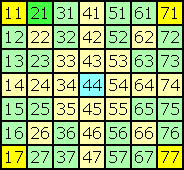 ---> --->K 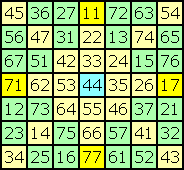 ---> --->K 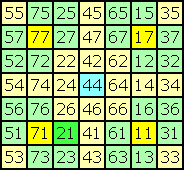 ---> --->KSquare 0Square 1Square 2 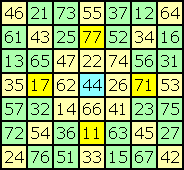 ---> --->K 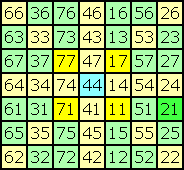 ---> --->K 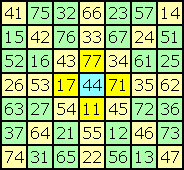 Square 3Square 4Square 5Transposition-Group The transpositions R, S and K generate a group of 48 different transpositions. One known order-7 square could be transposed into 47 other squares. If e is the total number of self-complementary pan-magic 7x7-squares then d = e / 8 is the number of unique squares (i.e. without rotated and reflected squares). But it is enough to count all essentially different squares c = e / 48. All other squares could be derived by applying a suitable transposition. Square 3Square 4Square 5Transposition-Group The transpositions R, S and K generate a group of 48 different transpositions. One known order-7 square could be transposed into 47 other squares. If e is the total number of self-complementary pan-magic 7x7-squares then d = e / 8 is the number of unique squares (i.e. without rotated and reflected squares). But it is enough to count all essentially different squares c = e / 48. All other squares could be derived by applying a suitable transposition. Axis-Cells K transposes each of the 24 yellow axis-cells to another axis-cell. Now look at the four numbers (11, 71, 17, 77) in the corner-cells of square 0. Notice that these numbers move through all yellow axis-cells by continued applying of K. Assume the number 1 is placed in any axis-cell. Then you always are able to move the number 1 to one of the corner-cells. If necessary an additional rotation brings the number 1 into cell (1,1). You need no reflection for this process. The square could be reflected at the downwards main diagonal to interchange n(2,1) and n(1,2) without changing n(1,1). Thus counting all squares with n(1,1) = 1 and n(2,1) < n(1,2) is enough to get the total number of all squares with 1 in any axis-cell. Filling-Cells K transposes each of the 24 green filling-cells to another filling-cell. Look at the number 21 in the squares 0, 2 and 4 that were produced by applying K2 once, twice or not at all. With rotations and reflections number 21 could be moved from these positions to all other filling-cells. Thus n(2,1) could be moved to any filling-cell by applying one of the 24 transpositions of the sub-group that is generated by R, S and K2. As you see in square 3, K3 interchanges n(1,1) and n(4,6), without changing n(2,1). Thus counting all squares with n(2,1) = 1 and n(1,1) < n(4,6) is enough to get the total number of all squares with 1 in any filling-cell. Formula of the transposition K K(x,y)=(v,w) means that the transposition K moves the number from cell (v,w) to cell (x,y). In the first formula x,y ranges from 1 to 7. K(x,y) = ( (y - x + 10) Mod 7 + 1 , (y + x + 2) Mod 7 + 1 ) The formula could be shortened by using coordinates x, y from 0 to 6:K(x,y) = ( (y - x + 10) Mod 7 , (y + x + 4) Mod 7 ) Reducing all calculations to the cyclic group (0, 1, ... 6), i.e. modulo 7, you get:K(x,y) = ( y - x + 3 , y + x - 3 ) This formula could be easily extended to other squares with odd order N = 2m + 1 and x, y from 0 to N-1, calculating modulo N:K(x,y) = ( y - x + m , y + x - m ) |
المشاركة : (4) | |
Confirmation of the Results On June 21st, 2004 an email came in from the French engineer Francis Gaspalou (email: العضو العزيز...شكر صاحب الموضوع للجهد الذي يقوم به لخدمة اهل العلم يشجعه لإعطاء عطاء أكبر . ضع رد لرؤية الرابط..), who is living in Gif-sur-Yvette near Paris. Here is a part of his email: "... I can confirm to you that I have found the same results, by a very similar method. The number of essentially different squares (3,365,114) can be divided by 2 : there are 96 transpositions for a given square, and not only 48. With a Duron 1,4 Ghz computer and a program in C language, I found in 12 days the 1,682,557 essentially different squares." The New Transposition W Francis Gaspalou called the new transposition W. He found it in August, 2000 when he examined regular ultramagic 7x7-squares. Each ultramagic square is transformed to another ultramagic square by applying transposition W. W is an involutory transposition, like S, R2 and K3. That means, you get the original square by applying W twice. 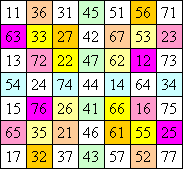 ---> --->W 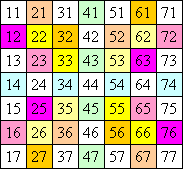 ---> --->W  The numbers in the white cells are fixed. Each other number is interchanged with a number in a cell of the same colour. The New Transposition-Group The transpositions R, S, K and W generate a group of 96 different transpositions. Thus there are only 20,190,684 · 8 / 96 = 1,682,557 essentially different ultramagic order-7 squares. The numbers in the white cells are fixed. Each other number is interchanged with a number in a cell of the same colour. The New Transposition-Group The transpositions R, S, K and W generate a group of 96 different transpositions. Thus there are only 20,190,684 · 8 / 96 = 1,682,557 essentially different ultramagic order-7 squares.Now the computation should take only half the time. Are there more general transpositions? No! As 1,682,557 is a prime the set of essentially different ultramagic order-7 squares can't be invariant relative to any further transposition. (Otherwise this transposition would generate a complete set of essentially different ultramagic order-7 squares and any pair of such squares would define such a transposition - that's not true.) What's Next? - The ideas of Francis Gaspalou will be explained in more detail. - The transpositions should be described in a better way. - The results can be arranged in a new order. |
المشاركة : (5) | |
العضو العزيز...شكر صاحب الموضوع للجهد الذي يقوم به لخدمة اهل العلم يشجعه لإعطاء عطاء أكبر . ضع رد لرؤية الرابط.. |
المشاركة : (6) | |
العضو العزيز...شكر صاحب الموضوع للجهد الذي يقوم به لخدمة اهل العلم يشجعه لإعطاء عطاء أكبر . ضع رد لرؤية الرابط.. |
المشاركة : (7) | |
ملفين عن المربعات السحريه Download the files as unzipped plain text files العضو العزيز...شكر صاحب الموضوع للجهد الذي يقوم به لخدمة اهل العلم يشجعه لإعطاء عطاء أكبر . ضع رد لرؤية الرابط.. (4123 kB)العضو العزيز...شكر صاحب الموضوع للجهد الذي يقوم به لخدمة اهل العلم يشجعه لإعطاء عطاء أكبر . ضع رد لرؤية الرابط.. (4123 kB) |
المشاركة : (8) | |
ملفين عن المربعات السحرية files العضو العزيز...شكر صاحب الموضوع للجهد الذي يقوم به لخدمة اهل العلم يشجعه لإعطاء عطاء أكبر . ضع رد لرؤية الرابط.. (4123 kB) العضو العزيز...شكر صاحب الموضوع للجهد الذي يقوم به لخدمة اهل العلم يشجعه لإعطاء عطاء أكبر . ضع رد لرؤية الرابط.. (4123 kB |
المشاركة : (9) | |
افتح هذه الوصلات بتفيدك العضو العزيز...شكر صاحب الموضوع للجهد الذي يقوم به لخدمة اهل العلم يشجعه لإعطاء عطاء أكبر . ضع رد لرؤية الرابط.. العضو العزيز...شكر صاحب الموضوع للجهد الذي يقوم به لخدمة اهل العلم يشجعه لإعطاء عطاء أكبر . ضع رد لرؤية الرابط.. العضو العزيز...شكر صاحب الموضوع للجهد الذي يقوم به لخدمة اهل العلم يشجعه لإعطاء عطاء أكبر . ضع رد لرؤية الرابط.. العضو العزيز...شكر صاحب الموضوع للجهد الذي يقوم به لخدمة اهل العلم يشجعه لإعطاء عطاء أكبر . ضع رد لرؤية الرابط.. العضو العزيز...شكر صاحب الموضوع للجهد الذي يقوم به لخدمة اهل العلم يشجعه لإعطاء عطاء أكبر . ضع رد لرؤية الرابط.. العضو العزيز...شكر صاحب الموضوع للجهد الذي يقوم به لخدمة اهل العلم يشجعه لإعطاء عطاء أكبر . ضع رد لرؤية الرابط.. العضو العزيز...شكر صاحب الموضوع للجهد الذي يقوم به لخدمة اهل العلم يشجعه لإعطاء عطاء أكبر . ضع رد لرؤية الرابط.. العضو العزيز...شكر صاحب الموضوع للجهد الذي يقوم به لخدمة اهل العلم يشجعه لإعطاء عطاء أكبر . ضع رد لرؤية الرابط.. العضو العزيز...شكر صاحب الموضوع للجهد الذي يقوم به لخدمة اهل العلم يشجعه لإعطاء عطاء أكبر . ضع رد لرؤية الرابط.. |
المشاركة : (10) | |
What's a multimagic square? A magic square is bimagic (or 2-multimagic) if it remains magic after each of its numbers have been squared. By extension, a square is P-multimagic if it remains magic after each of its numbers have been replaced by their k-th power (for k=1, 2, ..., to P). A reminder about what is a magic square. It is a square n x n sized (or n-th order) where we have succeeded in placing all the numbers from 1 to n², such that the sums of the n rows, n columns and 2 main diagonals are equal. Here is a sample of the smallest magic square (except the trivial order 1). This square was discovered by the Chinese more than 2000 years before JC! It is 3rd ordered, so contains all the numbers from 1 to 9.
The idea of multimagic squares started at the end of the XIXth century with the discovery in France of the first bimagic squares (or 2-multimagic). A magic square is bimagic if it remains magic after each of its numbers have been squared. Look at what happens to the Chinese square:
|
مواقع النشر (المفضلة) |
| الذين يشاهدون محتوى الموضوع الآن : 1 ( الأعضاء 0 والزوار 1) | |
 المواضيع المتشابهه المواضيع المتشابهه |
| الموضوع |
| دائرة المعارف السحريه |
| تعامل أهل أسرار الاوفاق مع طلاب علم الاوفاق |
| تعليم علم الحرف للمبتدأين |
| ألماء وفوائده السحريه !! |
| تعقيب علي شرح لغز الزيرجه للاح نعمان |